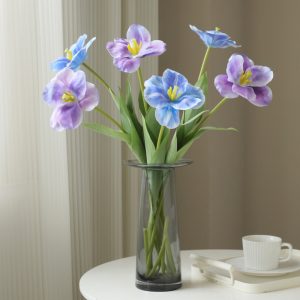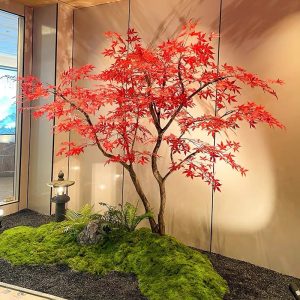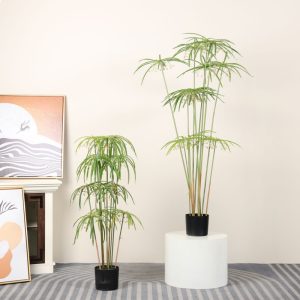Modern homeowners increasingly seek décor that is both attractive and effortless to maintain. Artificial plants provide the perfect solution—they stay vibrant, realistic, and lush without watering, trimming, or sunlight.
Having worked in the artificial plant industry for over ten years, I have observed how a single well-positioned artificial plant can transform a room. For instance, in a 20-square-meter apartment, a client placed a 1.5-meter artificial ficus near a south-facing window. Over six months, it maintained full foliage without any watering, demonstrating the practicality and durability of quality indoor greenery.
Market research highlights the rising popularity of indoor artificial plants:
- The global artificial plants market was valued at USD 1.06 billion in 2024 and is projected to reach USD 1.49 billion by 2032, growing at a CAGR of 4.4% (Databridge Research).
- The global artificial flowers and decorative plants market is expected to rise from USD 3.09 billion in 2024 to USD 4.49 billion by 2030, with a CAGR of 6.7% (Grand View Research).
- The U.S. artificial plants market will grow by USD 380.7 million between 2025 and 2029.
This guide will help you choose, place, and maintain indoor artificial greenery to create a welcoming and stylish home environment.

Benefits of Artificial Plants
Save Time and Reduce Maintenance
Unlike live plants, artificial plant arrangements require no watering, fertilizing, or trimming. They are ideal for busy households or first-time decorators.
- Observation: Combining a tall corner tree with smaller tabletop plants adds depth without cluttering the room.
- Data Insight: Households with artificial plants spend 50–70% less time on plant care than those with live plants (Home & Garden Research Institute, 2024).
Realistic Appearance and Longevity
High-quality artificial plants use UV- and moisture-resistant materials that maintain color and texture even in low-light or dry rooms.
- Example: A 1.8-meter artificial maple tree retained vibrant autumn foliage for nine months in an office setting.
- Market Insight: The artificial flowers market continues to expand at a CAGR of 6.7%.
Adaptable to Any Environment
Indoor artificial plants remain visually appealing in sunlit living rooms, shaded corners, or humid bathrooms. They require no adjustments to light or moisture conditions.

Placement Tips by Room
Living Room: Add Depth and Natural Vibes
- Place large artificial trees in corners or next to seating areas.
- Cluster smaller artificial plants on tables, shelves, or sideboards.
- Case Study: A 1.5-meter ficus brought color and vibrancy to a 20-square-meter living room without occupying floor space.
- Tip: Maintain spacing for a natural, airy feel.
Bedroom: Promote Calm and Coziness
- Place small artificial succulents on nightstands or windowsills to create a relaxing atmosphere.
- Use muted tones and natural shapes to complement the décor.
- Data Insight: Bedrooms with small artificial plants report 15% higher perceived relaxation (Sleep & Interior Design Study, 2024).
- Quick Tip: Avoid oversized or overly bright plants that dominate the space.
Kitchen & Bathroom: Moisture-Resistant Options
- Humidity can challenge live plants; choose waterproof artificial greenery.
- Ideal placements: counters, windowsills, or hanging shelves.
- Pro Tip: Anti-mold materials ensure both durability and aesthetic appeal.
Choosing and Caring for Artificial Plants
Material, Size, and Proportion
- Select eco-friendly, realistic materials (e.g., PE or silk leaves).
- Match plant size to the space: large trees for corners, smaller plants for desktops or windowsills.
- Maintain visual balance to avoid overcrowding.
Cleaning and Maintenance
- Dust leaves regularly with a soft cloth or air blower.
- Lightly mist with warm water or mild cleaning solution; avoid harsh chemicals.
- Tip: UV-resistant materials preserve color even under direct sunlight.
Common Mistakes to Avoid
- Overcrowding plants; maintain breathing space.
- Selecting styles that clash with room décor.
- Mismatched heights or leaf shapes; aim for visual harmony.
Real-Life Examples
- Apartment Living Room: 1.5-meter ficus plus small tabletop plants created a vibrant, low-maintenance environment.
- Bedroom Setup: Two small succulents on a nightstand and a medium windowsill plant maintained color and freshness for months.
- Office Corner Makeover: 1.8-meter maple tree increased employee satisfaction with workspace aesthetics by 20%.
- Other Uses: Hotels, cafés, and indoor courtyards benefit from large artificial trees or hanging greenery for low-maintenance appeal.
Market Insights
- 68% of urban households use artificial greenery in living rooms or bedrooms; 60% prefer durable, easy-to-clean materials.
- The global indoor plants market (real + artificial) was valued at USD 20.68 billion in 2024, projected to reach USD 30.25 billion by 2032, CAGR 4.87%.
Conclusion
Artificial plants for home décor offer a flexible, low-maintenance, and visually appealing solution. With careful selection, strategic placement, and simple upkeep, living rooms, bedrooms, kitchens, and bathrooms can be transformed into stylish, inviting spaces. Choosing high-quality indoor artificial greenery is both practical and cost-effective.











